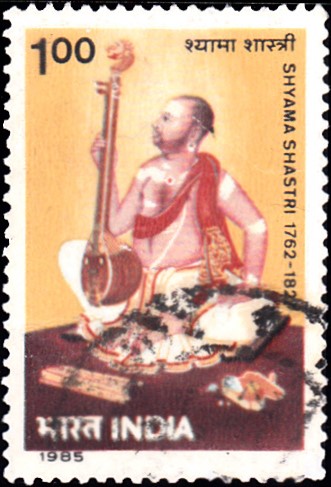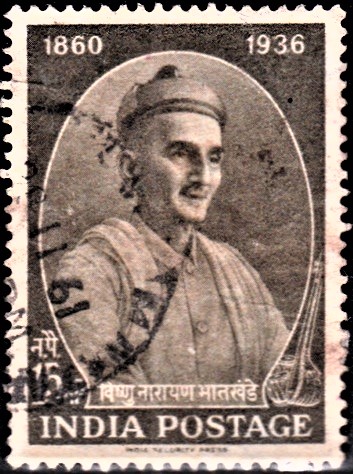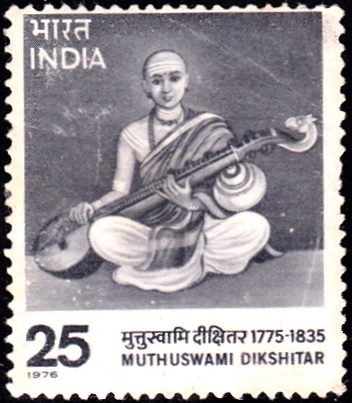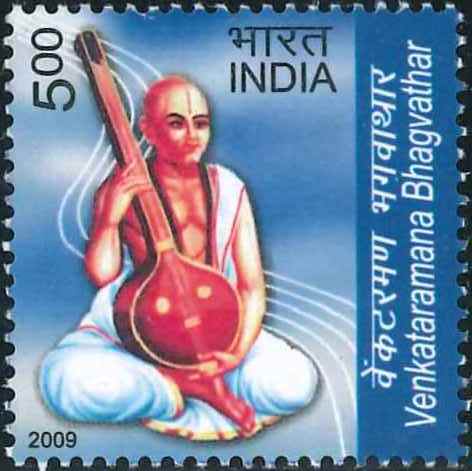
Shyama Shastri
A commemorative postage stamp on Talaprasthara Syama Sastri, oldest among the Trinity of Carnatic music, with Tyagaraja and Muthuswami Dikshitar :
 Issued by India
Issued by India
Issued on Dec 21, 1985
Issued for : The Department of Posts is privileged to issue a commemorative stamp on Shyama Shastri, a great artist of India.
Description of Designs : The 100 p. multicolour stamp of Shyama Shastri has been designed by India Security Press, Nashik Road. The First Day Cover and the cancellation designs have been prepared by Nenu Bagga.
Type : Stamp, Postal Used
Colour : Multi colour
Denomination : 100 Paise
Overall Size : 4.06 x 2.73 cms.
Printing Size : 3.71 x 2.38 cms.
Perforation : 13 x 13
Paper : Unwatermarked adhesive stamp paper
Number printed : 15,00,000
Number per issue sheet : 40
Printing Process : Photogravure
Printed at : India Security Press
Name : Syama Sastri
Born on Apr 26, 1762 at Tiruvarur, Thanjavur district, Tamil Nadu, India
Died on Feb 6, 1827 at Thanjavur, Tamil Nadu, India
About :
- Shyama Shastri, eldest of the “Trinity” of Carnatic Music was born in Tiruvarur on the 26th April, 1762. He was educated in Sanskrit and Telugu and is said to have learnt the rudiments of music from his uncle. The family moved to Thanjavur in 1781 and here he came under the influence of a Sanyasi “Sangitha Swami“, and mastered the intricacies of the art. His knowledge was also enlarged by association with Pachchimiriyam Adiyappayya, the Court musician. In spite of the reluctance of the family to let him adopt a musical career, he made great progress both as a musician and as a composer and eventually came to be reckoned as one of the “Trinity” of Carnatic Music.
- Shyama Shastri‘s compositions are original and have a style of their own. They are in slow tempo and the Raga (melody type) delineated in a few clear phrases full of Raga Bhava. He has composed both in well known and rare Ragas but he chose Ragas whose form is depicted more by Sancharas (movements) and gamakas (graces) than by the bare notes. He was also a master of Laya (Rhythm) and we find unusual inversion of beats in some of his compositions in Misrachapu Tala. It is said that he had won musical contests by his command over laya. Swarajati which was basically a dance form was developed by him into a beautiful musical form fit for concerts.
- His compositions are in praise of Goddess Kamakshi and Minakshi and are in Sanskrit, Telugu and Tamil (Shyama Shastri was the only one among the Trinity to have composed in Tamil). The songs have the signature ‘Shyama Krishna‘. Though he was named Venkata Subrahmanya, he was called by the pet name ‘Shyama Krishna‘ which he adopted as the ankitam.
- Shyama Shastri was a highly creative artist. The melodic form of his composition is strikingly original, unconventional and free, rich in emotional content. His compositions are in common ragas like Todi, Dhanyasi, Kambhoji, Yadukulakambhoji, Sankarabharanam and Kalyani and in uncommon ragas like Kalagada, Karnataka Kapi, Manji and Chintamani. He is acclaimed as the architect of the musical form, Svarajati. Shyama Shastri has also composed nine Kritis in praise of “Minakshi“, the Deity of the temple in Madurai. This group is called Navaratna–Malika.
- Shyama Shastri passed away on February 6, 1827 when he was only 65 years.







